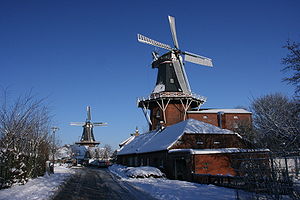Deichmühle
| Deichmühle
|
||
|---|---|---|
|
Deichmühle in winter, in the background the Frisia mill |
||
| Location and history | ||
|
|
||
| Coordinates | 53 ° 35 '24 " N , 7 ° 12' 52" E | |
| Location |
|
|
| Built | 1900 | |
| Status | functional technical monument | |
| technology | ||
| use | Flour mill | |
| drive | Windmill | |
| Windmill type | Gallery Dutch windmill | |
| Wing type | Louvre flaps | |
| Number of wings | 4th | |
| Tracking | Compass rose | |
| Website | http://www.deichmuehle.de/ | |
The dike mill is under monument protection standing Dutch windmill in the north (Ostfriesland) in Lower Saxony . It is one of the city's landmarks and is located in the Süderneuland I district .
investment
The functioning gallery Dutch windmill in the south-north serves today as a mill museum. In addition to the mill built in 1900, the mill also has an old miller's house from around 1700, the gable of which, however, was renewed in 1900 in the style of historicism . The engine house built in 1908, the packing house built in 1921 and a new miller's house built in 1923 are also listed as historical monuments. In the buildings there are various historical machines that document the technical development of the miller's trade. Not far from the dike mill , the Frisia mill has been preserved.
history
A wooden post mill has probably stood at the current location of the mill since the 13th century . Due to its location on the port dike in the city of Norden, the name Deichmühle, which is still in use today, resulted. In 1597 the mill was rebuilt after it had been destroyed by Count Edzard II. Another partial destruction took place during the class war . In 1734 the mill went from princely ownership to a miller. At the end of the 19th century the mill belonged to the miller Ulfert, who planned a new building, but died before the plans were implemented. His wife sold the mill to the miller Weert Meyer, who first repaired the post mill so that he could continue to work. However, the growing development of the surrounding area further restricted the usability of the mill. Meyer decided to build a tall, three-story, more modern gallery Dutch windmill. However, a first building application was rejected for fire protection reasons. In the opinion of the authorities, a fire in the mill would be too dangerous for the surrounding buildings and several wood storage areas. In response to a complaint from Meyers to the regional president in Aurich , however, he received a building permit with strict fire protection requirements. The roof of the mill had to be made of sheet metal and have a lightning rod . In addition, an iron vane shaft had to be used. In 1900 the technically outdated post mill was demolished and the present mill was built instead. It was used to grind flour and pearl barley . Contrary to the original plan, Meyer even built it with four floors. The construction work was the responsibility of the mill builder Dirks from Emden . The new mill started operations at the end of 1900. The interior furnishings were completed in 1901.
To become more independent from the wind, the engine house was built in 1908. With the gas engine located here , operation was possible even when there was insufficient wind. In 1913 a device for automatically rotating the cap with a tapered roller ring and compass rose was added.
In 1919 Gerd Meyer, the son of Weert Müller, sold the Deichmühle to Rolf Bontjes from Leezdorf . Bontjes expanded the mill, which had run into economic difficulties. He built a three-story warehouse to dry and store the grain, expanded the engine house, and built the new home. Parts of the site were then also leased to other companies. For example, the Wilken-Tee company used parts of the residential and warehouse to mix and pack tea. However, the economic situation and with it the structural condition of the mill deteriorated in the 1930s. One of the wings broke off after a lightning strike. The compass rose was also broken. During the Second World War , Bonte received orders for army supplies , which improved his economic situation. Even in the post-war period, the mill was initially still successful. Pearl barley was produced for Edeka and the consumer association . In 1947 it was repainted, in 1948 a new wing and weather bar . In 1957 the mill was leased to MO Kalverkamp. Kalverkamp bought an electric sack lift . The mill was also used to store grain and manure and to produce animal feed. Wind power was still used at the Deichmühle until around 1968 . In 1974 the entire commercial operation finally followed.
In the same year, Maria Anna and Hermann Wagener from Papenburg bought the mill, made it functional again and created the present day use as a museum. First, after a restoration by a Dutch mill builder, the wind power was restored. It was also opened to holiday guests. With the construction of the main road leading past the mill, including a larger intersection in the immediate vicinity of the mill, a lengthy dispute arose between the mill owner and the authorities, but the road construction plans did not change. The close proximity to the Großstrasse characterizes the area surrounding the mill.




